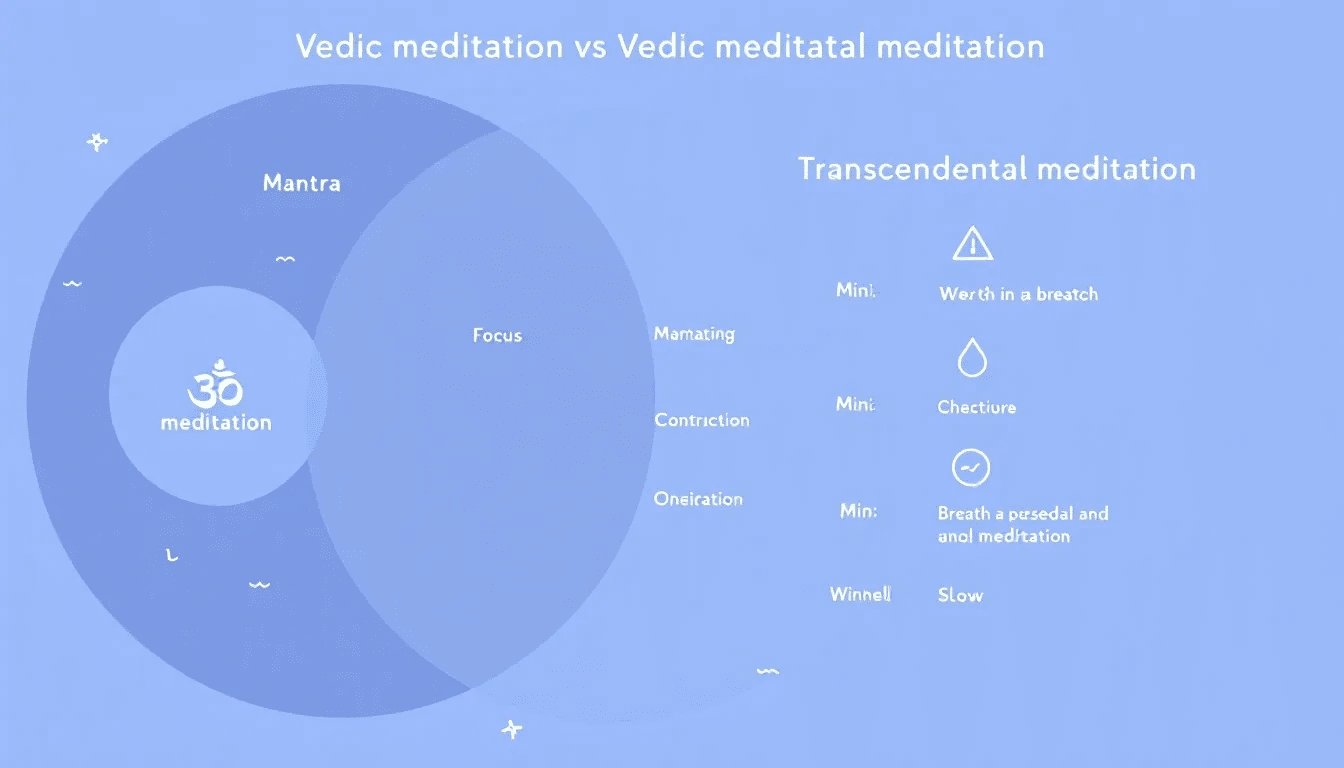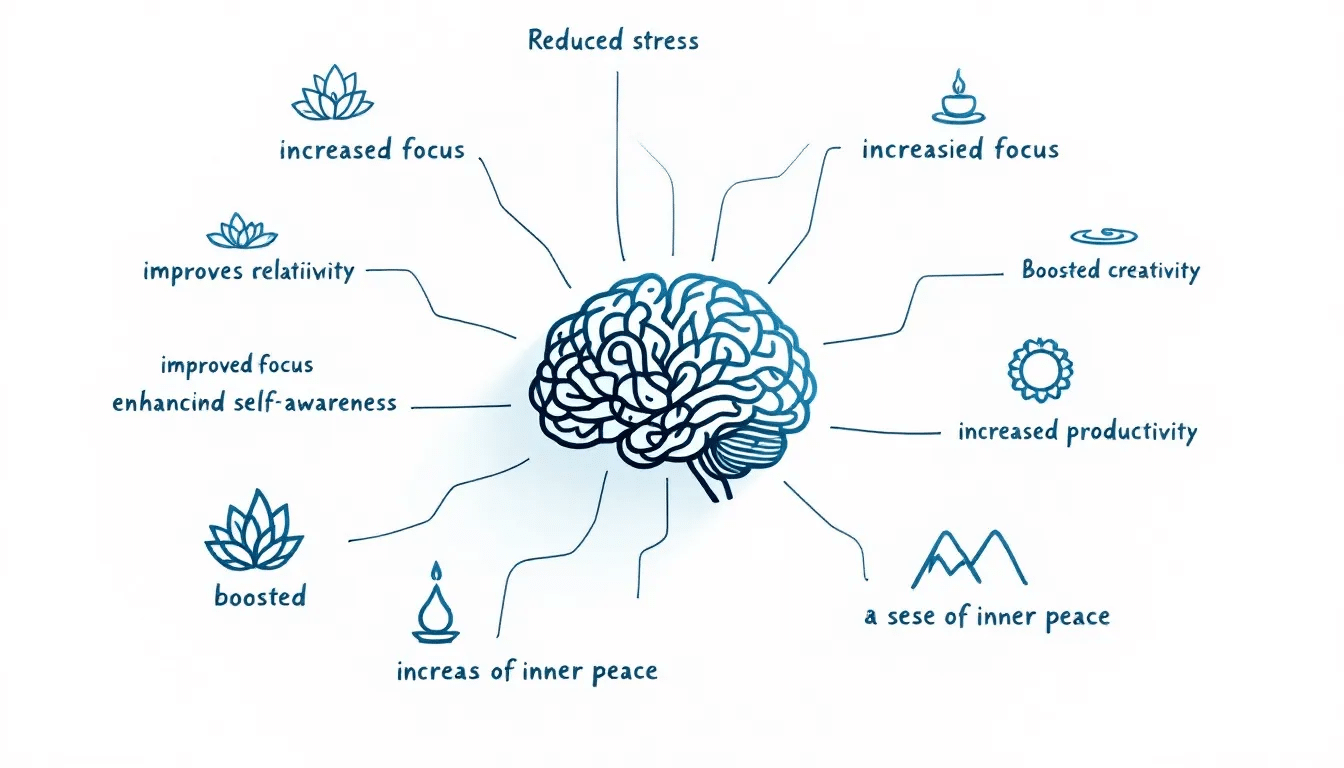Curious about Vedic Meditation vs Transcendental Meditation? They both calm the mind but differ in method and philosophy. This article compares their techniques, instruction styles, and benefits to help you choose the right practice for your needs.
Understanding Vedic Meditation

Vedic Meditation, steeped in the ancient wisdom of the Vedas and vedic knowledge, has been practiced for over 5,000 years. This form of meditation is distinct in its simplicity and accessibility, allowing practitioners to achieve a peaceful state effortlessly. Unlike other meditation techniques that require intense concentration, you can learn Vedic Meditation, which uses a mantra, a sound derived from ancient Hindu Sanskrit, to guide the mind to quieter states of awareness. Vedic mediation offers a unique approach to achieving inner peace.
Practitioners sit comfortably, silently repeating a personal mantra chosen by a qualified instructor. This helps ground the mind, enabling deep rest and the release of stored stress and trauma. The effortless nature of Vedic Meditation distinguishes it from other methods, creating a therapeutic alignment with the principles of Ayurveda, yoga, and deep meditation, as well as insights from Indian philosophy. Many choose to practice vedic meditation to enhance their overall well-being.
Vedic Meditation is recognized as a universal practice, accessible to anyone regardless of background. Its focus on effortless practice allows individuals to let go of their thoughts and achieve deep relaxation. This technique fosters mental clarity, emotional well-being, and a deeper connection to one’s authentic self.
The Essence of Transcendental Meditation (TM)
Transcendental Meditation (TM) was introduced to the West by Maharishi Mahesh Yogi in the 1960s, bringing a structured approach to the practice of silent mantra meditation. The process of learning TM is comprehensive, beginning with an introductory talk, followed by a ceremonial honor, personal instruction, and continued guidance from certified teachers. This structured approach ensures that practitioners can maximize the benefits of TM, which include mental clarity and deep relaxation.
The primary technique in TM is the silent repetition of a personal mantra, assigned by an accredited instructor. This method enables individuals to reach a state of restful alertness, where the mind is calm yet fully awake. This state, often referred to as “restful alertness,” promotes profound health benefits, including reduced anxiety and enhanced emotional well-being.
TM emphasizes a structured, supportive learning environment provided by expert teacher TM teachers within a TM organization. It offers flexible learning options through certified instructors, making it accessible to a broader audience. This structure and flexibility help practitioners achieve deeper states of consciousness and overall well-being.
Key Differences Between Vedic and Transcendental Meditation

Although both Vedic Meditation and Transcendental Meditation aim to calm the mind, their methods and approaches significantly differ. Vedic Meditation focuses on a more effortless practice that can be self-taught, relying on broader principles and personal mantras. In contrast, Transcendental Meditation requires structured learning from certified teachers, with specific mantras assigned to each practitioner by their instructor. When considering meditation vs other relaxation techniques, the differences become even more pronounced.
Both use mantras to guide the mind, yet their selection and usage differ. Vedic Meditation allows for a more personalized connection with mantras selected from ancient texts, while TM mantras are typically assigned in Sanskrit by an instructor.
Despite their significant differences, both methods use the same technique and are straightforward, requiring little effort while offering a significant difference in benefits such as mental clarity, reduced stress, overall well-being, and living in the best investment world in their natural state. Many individuals feel stressed by the demands of daily life, highlighting the main differences between these approaches and other techniques in the same way.
Instruction Methods
A key difference between Vedic Meditation and Transcendental Meditation lies in their instruction methods. Vedic Meditation is traditionally taught in-person over four consecutive days by qualified instructors. This face-to-face interaction ensures practitioners grasp the technique and integrate it into their daily routines.
Transcendental Meditation, on the other hand, offers a more structured learning approach that includes personal instruction from certified teachers. This process involves an introductory talk, a ceremonial honor, personal instruction, and continued guidance. Unlike Vedic Meditation, TM allows for flexible learning options, making it accessible to more people regardless of their schedule or location.
Personalized Mantras
Personalized mantras play a crucial role in both Vedic Meditation and Transcendental Meditation, but their selection and significance differ. In Vedic Meditation, mantras are chosen from ancient texts, providing a deep personal connection to the practice. These mantras are intended to resonate with the individual, helping them achieve a quieter state of awareness during meditation.
Transcendental Meditation also uses personalized mantras, but these are typically assigned in Sanskrit by an instructor based on specific criteria. This structured approach ensures that the mantra is best suited to the individual’s needs, aiding in achieving deeper states of relaxation and consciousness through deep transcendental meditation and mantra based meditation techniques.
Both practices emphasize the importance of personalized mantras in enhancing the forms of meditation experience and achieving transcendent states.
Enhance Your Meditation with ‘Om Mani Padme Hum’ Music
For those looking to deepen their meditation practice, incorporating music can be a powerful tool. Our ‘Om Mani Padme Hum’ meditation music offers a unique mantra meditation experience, designed to complement both Vedic and Transcendental Meditation practices. This soothing orchestral arrangement helps guide the mind to a peaceful state, enhancing the overall meditation journey.
The ‘Om Mani Padme Hum’ mantra is renowned for its calming effects and spiritual significance, making it an ideal addition to your meditation space. Whether you’re practicing mantra based meditation techniques or simply seeking a tranquil background for your meditation sessions, this music can facilitate deeper relaxation and mindfulness.
Explore our ‘Om Mani Padme Hum’ meditation music and elevate your meditation practice. Visit Orchestral Meditations to learn more and download today.

Community and Support
The community aspect of meditation practices can significantly enhance the practitioner’s journey. Vedic Meditation offers a supportive environment where practitioners can deepen their practice through ongoing guidance from experienced mentors and fellow meditators.
This community support includes access to traditional teachings and additional training sessions to teach knowledge, fostering a sense of belonging and continuous growth among independent teachers.
Benefits of Practicing Vedic Meditation

Engaging in Vedic Meditation offers numerous benefits beyond simple relaxation. One of the primary advantages is the profound reduction in stress. Vedic Meditation calms the mind, releasing stored stress and trauma, and promoting deep relaxation. Research has shown that this practice reduces stress chemistry and improves brain function, leading to better mental clarity and emotional well-being.
Regular engagement in Vedic Meditation can enhance cognitive function, creativity, and problem-solving abilities. Practitioners often report a greater ability to react to daily situations with calm and balance, contributing to overall emotional control and a more positive mood. This deeper connection with one’s self fosters inner peace and alignment with authentic inclinations, making Vedic Meditation a powerful tool for personal growth.
In addition to these mental and emotional benefits, Vedic Meditation supports physical health by promoting relaxation and reducing the body’s stress response. Rooted in Ayurvedic principles, this holistic approach makes Vedic Meditation a therapeutic practice that significantly enhances overall well-being.
Advantages of Transcendental Meditation

Transcendental Meditation is celebrated for its significant impact on mental and physical health. Scientific studies have demonstrated that regular practice of TM can significantly reduce symptoms of anxiety and enhance emotional well-being. This practice is particularly beneficial for individuals dealing with high levels of stress, as it promotes deep relaxation and mental clarity.
In addition to its mental health benefits, TM has been associated with improved cognitive functions, including enhanced memory and mental alertness. Regular practice of TM can also lead to lower blood pressure and reduced stress levels, contributing to overall physical health.
For individuals with PTSD, TM can reduce anxiety symptoms by up to 53-62%, highlighting its effectiveness in managing severe stress and trauma.
Common Misconceptions About Meditation
Despite its growing popularity, meditation is often surrounded by misconceptions that can deter people from trying it. One common misconception is that meditation is only for those who follow a particular spiritual or religious tradition. In reality, meditation is a universal practice accessible to individuals from all backgrounds and belief systems. It does not require adherence to any specific religious doctrine and can be practiced by anyone seeking mental and emotional well-being.
Another misconception is that meditation requires significant lifestyle changes, such as dietary restrictions or long-term commitments. However, meditation is fundamentally a mental practice aimed at calming and training a busy mind. It does not necessitate altering one’s lifestyle or habits, and even short, regular sessions can yield immediate benefits.
Clarifying these misconceptions can help more people embrace meditation as a practical tool for enhancing their quality of life.
How to Start Your Meditation Journey

Starting a meditation journey can be transformative. The first step is to find a peaceful setting, whether it’s a quiet room in your home or a comfortable spot in nature. A quiet place free from disturbances helps create a conducive environment for meditation. Using a cushion or chair can also enhance comfort, allowing you to focus more on the practice.
Selecting a mantra is a crucial part of the process, as it should be a sound that resonates without meaning, allowing the mind to relax deeper. During meditation, observing your breathing and posture helps cultivate awareness of your physical state, further enhancing the practice.
After meditating, taking time to express gratitude and reflect on your experience can deepen your connection to the meditation practice and integrate its benefits into your daily life. With regular practice, you can learn meditation, and it can become a natural and enjoyable part of your routine.
Expert Insights from Thom Knoles and Maharishi Mahesh Yogi
Thom Knoles, a prominent teacher of Vedic Meditation, and Maharishi Mahesh Yogi, the founder of Transcendental Meditation, have greatly contributed to the understanding and dissemination of these practices. Thom Knoles emphasizes the effortless nature of Vedic Meditation, encouraging practitioners to integrate the practice seamlessly into their daily lives. His teachings highlight the therapeutic benefits of the practice, aligning with Ayurvedic principles and promoting overall well-being.
Maharishi Mahesh Yogi revolutionized the way meditation is perceived in the West by introducing Transcendental Meditation. His structured approach to teaching TM, including personal instruction and ongoing support, ensures that practitioners can achieve deep states of restful alertness and mental clarity. The insights from these experts underscore the profound impact that both Vedic and Transcendental Meditation can have on an individual’s mental, emotional, and physical health.
Summary
In summary, both Vedic Meditation and Transcendental Meditation offer unique paths to achieving inner peace, mental clarity, and overall well-being. Vedic Meditation, with its roots in ancient Vedic knowledge, emphasizes an effortless practice using personalized mantras to guide the mind to quieter states of awareness. On the other hand, Transcendental Meditation, introduced by Maharishi Mahesh Yogi, offers a structured learning approach that promotes deep relaxation and mental clarity through the use of silent mantra meditation.
Choosing the best practice depends on individual preferences and needs. Whether you resonate more with the self-taught, effortless nature of Vedic Meditation or the structured, guided approach of Transcendental Meditation, both practices provide profound benefits. As you embark on your meditation journey, remember that the ultimate goal is to find a practice that aligns with your lifestyle and helps you achieve a state of inner peace and balance.
Frequently Asked Questions
What is the main difference between Vedic Meditation and Transcendental Meditation?
The main difference between Vedic Meditation and Transcendental Meditation lies in their teaching methods; Vedic Meditation can be self-taught with personalized mantras, whereas Transcendental Meditation necessitates learning from certified instructors with assigned mantras.
How long does it take to learn Transcendental Meditation?
Learning Transcendental Meditation generally takes a few days to a week, including an introductory session and personal instruction from a certified teacher. This structured approach ensures proper understanding and practice.
Are personalized mantras important in both Vedic and Transcendental Meditation?
Personalized mantras are indeed crucial in both Vedic and Transcendental Meditation, as they significantly enhance the meditation experience and facilitate deeper states of awareness.
Can anyone practice Vedic Meditation?
Yes, Vedic Meditation is accessible to individuals from all backgrounds and can be practiced effortlessly to achieve deep relaxation.
What are the health benefits of practicing Transcendental Meditation?
Practicing Transcendental Meditation can significantly enhance your health by reducing anxiety, lowering blood pressure, and improving cognitive functions. This practice contributes to overall mental and physical well-being.



